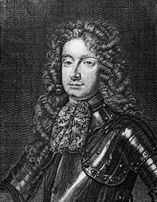Active 1688-1922 Size 550 | Role Heavy Cavalry | |
 | ||
Country Kingdom of England (1688–1707) Kingdom of Great Britain (1707–1746, 1788–1800) Kingdom of Ireland (1746–1788) United Kingdom (1801–1922) | ||
The 7th (The Princess Royal's) Dragoon Guards was a cavalry regiment in the British Army, first raised in 1688 as Lord Cavendish's Regiment of Horse. It was renamed as the 7th (The Princess Royal's) Dragoon Guards for Princess Charlotte in 1788. It saw service for two centuries, including the First World War, before being amalgamated with the 4th Royal Irish Dragoon Guards, to form the 4th/7th Dragoon Guards in 1922.
Contents
History
The regiment was first raised by William, Lord Cavendish as Lord Cavendish's Regiment of Horse in 1688 in the aftermath of the Monmouth Rebellion, by the regimenting of various independent troops, and was ranked as the 9th Horse from 1690. It fought at the Battle of the Boyne in July 1690 during the Williamite War in Ireland. The regiment then took part in the Battle of Dottignies in July 1693 and, having been re-ranked as the 8th Horse from 1694, at the siege of Namur in July 1695 during the Nine Years' War. It then fought at the Battle of Blenheim in August 1704, the Battle of Elixheim in July 1705, the Battle of Ramillies in May 1706 and the Battle of Malplaquet in September 1709 during the War of the Spanish Succession.
A charge by the regiment was decisive in defeating the French forces at the Battle of Dettingen in June 1743 before the regiment took part in a serious reverse at the Battle of Fontenoy in May 1745 during the War of the Austrian Succession. Four troops from the regiment fought on foot at the Clifton Moor Skirmish in December 1745 during the Jacobite rising. In 1746 it was transferred to the Irish establishment, where it was ranked as the 4th Regiment of Horse, or the "Black Horse", in which capacity it next saw action at the Battle of Warburg in July 1760 during the Seven Years' War. It transferred back to the British establishment in 1788 as the 7th (The Princess Royal's) Dragoon Guards for Princess Charlotte. A squadron led by Lieutenant-Colonel Mahon captured the town of Rathangan at the Battle of Rathangan in May 1798 during the Irish Rebellion.
The regiment took part in the Seventh Xhosa War between 1846 and 1847. The regiment next saw action at the Battle of Mahsameh in August 1882, the Battle of Kassassin also in August 1882 and the Battle of Tel el-Kebir in September 1882 during the Anglo-Egyptian War.
Following the outbreak of the Second Boer War in late 1899, the regiment was again sent abroad for service in South Africa. A total of 24 officers and 500 men left Southampton in the SS Armenian on 8 February 1900. The regiment fought at the Battle of Diamond Hill in June 1900.
The regiment, which had been serving in Secunderabad at the start of the First World War, landed in Marseille as part of the 9th (Secunderabad) Cavalry Brigade in the 1st Indian Cavalry Division in October 1914 for service on the Western Front. A squadron from the regiment rode ten miles to capture the town of Lessines on 11 November 1918 shortly before the armistice. It was re-titled as the 7th Dragoon Guards (Princess Royal's) in 1921, and was amalgamated with the 4th Royal Irish Dragoon Guards, to form the 4th/7th Dragoon Guards in 1922.
Battle honours
The regiment's battle honours were as follows:
Colonels
The colonels of the regiment were as follows:
from 1693 8th Regiment of Horse
in 1746 transferred to the Irish establishment and ranked
On 1 July 1751 a royal warrant provided that in future regiments would not be known by their colonels' names, but by their "number or rank".
in 1788 transferred to the British establishment and ranked
from 1921 7th Dragoon Guards (Princess Royal's)
from 1922 4th/7th Dragoon Guards after amalgamation with 4th Royal Irish Dragoon Guards
